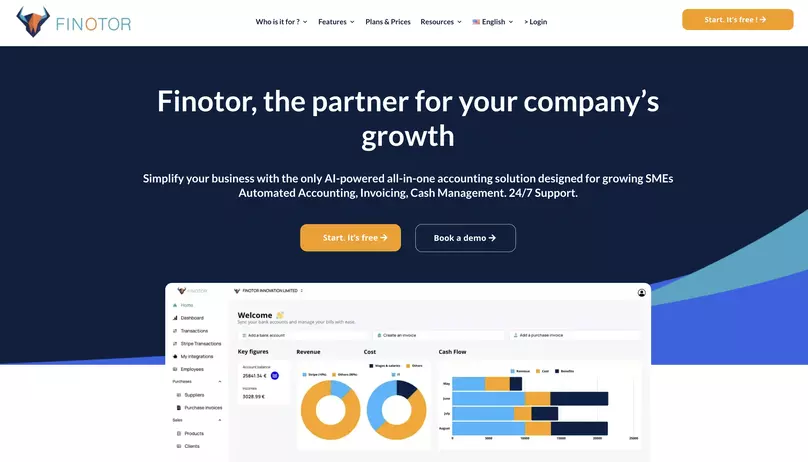Contents
- 1 Understanding the cost of goods sold (COGS)
- 2 The essential cost of goods sold formula
- 3 Real-World Applications
- 4 COGS in Different Industries
- 5 Importance of COGS in business decision-making
- 6 COGS and Gross Profit Margin
- 7 Advanced considerations in COGS calculation
- 8 Maximizing the value of COGS insights
- 9 Tips for Entrepreneurs Regarding Cost of Goods Sold (COGS)
- 10 FAQ: How to Calculate Cost of Goods Sold (COGS) – Essential for Business Profitability
The Cost of Goods Sold formula (COGS) is a fundamental tool for businesses to measure profitability and make informed financial decisions. As a seasoned business advisor, I’ve witnessed firsthand the impact of accurate COGS calculations on a company’s bottom line. In this article, we’ll delve into the intricacies of COGS, its importance, and how to calculate it effectively.
Understanding the cost of goods sold (COGS)
COGS are the direct costs associated with the production of goods that a company like yours sells over a given period. These costs are essential for determining gross profit and overall profitability. In my experience guiding companies towards growth, I’ve found that a clear understanding of COGS is fundamental to strategic planning and pricing decisions.
Components of COGS
- Direct Materials: The raw materials directly used in production.
- Direct Labor: Wages and labor costs for workers directly involved in manufacturing.
- Manufacturing Overhead: Indirect costs like rent, utilities, and equipment depreciation.
- Beginning Inventory: The value of inventory at the start of the period.
- Ending Inventory: The value of inventory at the end of the period.
Time Period
COGS can be calculated for different periods representing the time period:
- Annual
- Quarterly
- Monthly
Inventory Valuation Methods
Different valuation methods affect COGS:
- FIFO (First-In, First-Out): Assumes the first inventory bought is the first sold.
- LIFO (Last-In, First-Out): Assumes the most recent inventory is sold first.
- Weighted Average: Uses an average cost for all units.
Remember that COGS excludes indirect expenses such as sales force salaries, distribution and administrative expenses. These are categorized as operating expenses (OPEX) and are handled separately in financial statements.
In 2023, a study by the National Association of Manufacturers revealed that manufacturing costs accounted for an average of 67% of a product’s final price, highlighting the significant impact of COGS on pricing strategies.
The essential cost of goods sold formula
The basic cost of goods sold formula is straightforward yet powerful:
COGS = Beginning Inventory + Purchases – Ending Inventory
This formula provides a snapshot of the costs directly tied to the production of goods sold during a specific period. Accurately recording the level of inventory sold during the reporting period is key to for assessing profitability and managing expenses. Let’s break down each component:
- Beginning Inventory: The value of inventory at the start of the accounting period
- Purchases: The cost of goods bought or produced during the period
- Ending Inventory: The value of inventory remaining at the end of the accounting period
To illustrate this concept, let’s consider a simple example with $ or €:
| Component | Value |
|---|---|
| Beginning Inventory | $50,000 |
| Purchases | $200,000 |
| Ending Inventory | $30,000 |
Applying the COGS formula :
Component Value Beginning Inventory $50,000 Purchases $200,000 Ending Inventory $30,000
COGS = $50,000 + $200,000 – $30,000 = $220,000
This calculation reveals that the cost of goods sold for this period is $220,000. As a co-founder of multiple businesses supporting corporate development, I’ve implemented AI-powered financial management solutions like Finotor (www.finotor.com) to automate and streamline COGS calculations, ensuring accuracy and efficiency in financial reporting.
This allows the possibility to calculate cost and Direct cost of goods sold formula. The labor costs directly related with the direct cost of goods sold formula.
Real-World Applications
- Retail Business: Calculating COGS to assess profitability and make inventory decisions. COGS can vary significantly across different industries, depending on the type of products or services being sold and the costs typically associated with production.
- Manufacturing Company: Using COGS for production efficiency and pricing strategies.
- Restaurant: Analyzing COGS for menu pricing and inventory management.
- E-commerce Business: Using COGS to evaluate product line profitability.
Read more articles in the category Ecommerce & Strategy
COGS in Different Industries
COGS can vary significantly across different industries, depending on the type of products or services being sold. Here are some examples of how COGS can differ in various industries:
- Manufacturing: In the manufacturing sector, COGS encompasses the cost of raw materials, direct labor, and overhead costs such as factory rent and equipment depreciation. For instance, a car manufacturer would include the cost of steel, labor for assembly, and the depreciation of machinery used in production.
- Retail: In retail, COGS includes the cost of purchasing inventory, shipping costs, and storage costs. For example, a clothing retailer would account for the purchase price of garments, the cost of shipping them to the store, and the expenses related to warehousing.
- Service-based industries: In service-based industries such as consulting or software development, COGS may include the cost of labor, overhead costs, and any materials or equipment used to deliver the service. For a software development firm, this could mean the salaries of developers, the cost of software licenses, and the depreciation of computers.
- Agriculture: In agriculture, COGS may include the cost of seeds, fertilizers, equipment, and labor. A farmer would consider the expenses for seeds, the cost of fertilizers to enhance crop yield, the depreciation of farming equipment, and the wages paid to farmhands.
Understanding the specific components of COGS in your industry is a prerequisite for accurate financial reporting and strategic decision-making. By accurately tracking these costs, businesses can better manage their expenses and improve profitability.
Importance of COGS in business decision-making
Understanding and accurately calculating COGS is vital for several reasons, including its impact on the income statement, where it is used to determine gross profit and overall profitability:
- Profitability analysis : COGS is deducted from revenue to calculate gross profit, a key indicator of a company’s financial health.
- Pricing strategies : Knowing your COGS helps in setting competitive yet profitable prices for your products.
- Tax deductions : COGS is a legitimate business expense that can be deducted from your taxable income.
- Inventory management : Tracking COGS helps in optimizing inventory levels and identifying inefficiencies in the production process.
In my 15 years of experience guiding companies, I’ve observed that businesses with a firm grasp on their COGS are better equipped to make informed decisions about scaling production, entering new markets, or diversifying their product lines.
It’s worth noting that different industries may have varying approaches to COGS. For instance, retailers typically include costs like sales tax, freight, and warehousing in their COGS calculations. Manufacturers, on the other hand, focus on raw materials, production labor, and factory overhead.
COGS and Gross Profit Margin
COGS is a critical component of a company’s gross profit margin, which is the difference between revenue and COGS. The gross profit margin is a key indicator of a company’s profitability and is often used to evaluate its financial performance.
- Gross Profit Margin Formula: The formula for calculating gross profit margin is straightforward: Gross Profit Margin = (Revenue – COGS) / Revenue
- Importance of Gross Profit Margin: A high gross profit margin indicates that a company is able to sell its products or services at a price that is significantly higher than its COGS, resulting in higher profits. This is a sign of strong pricing power and efficient cost management. Conversely, a low gross profit margin may indicate that a company is struggling to maintain profitability due to high COGS or intense competition, which can erode pricing power.
By understanding COGS and its relationship to gross profit margin, businesses can make informed decisions about pricing, inventory management, and cost control to optimize their financial performance. Regularly analyzing your gross profit margin can help identify trends, uncover inefficiencies, and guide strategic adjustments to enhance profitability.
Advanced considerations in COGS calculation
While the basic COGS formula is a good starting point, there are several advanced considerations to keep in mind :
Key points Details Definition of COGS Represent direct costs associated with producing goods sold during a specific period COGS formula Calculate COGS using : Beginning Inventory + Purchases – Ending Inventory Importance in business Use for profitability analysis, pricing strategies, tax deductions, and inventory management Advanced considerations Choose appropriate inventory valuation method (FIFO, LIFO, or Average Cost) Maximizing COGS insights Regularly analyze trends, benchmark against industry standards, and use for forecasting
Inventory valuation methods can significantly impact COGS calculations. The three primary methods are :
- First-In, First-Out (FIFO)
- Last-In, First-Out (LIFO)
- Average Cost
Each method can yield different COGS figures, affecting your reported profits. It’s a important step to choose a method that best represents your business operations and stick to it consistently for accurate year-to-year comparisons.
Another important aspect is the distinction between COGS and operating expenses (OPEX). While COGS directly relates to production, OPEX covers indirect costs like marketing, rent, and administrative salaries. Understanding this difference is importante for accurate financial reporting and analysis.
It’s also worth noting that service companies typically don’t have COGS in the traditional sense. Instead, they may report “cost of services” which includes direct labor and materials used in providing services.
As an entrepreneur who has leveraged AI in financial management, I can attest to the power of software and automation in COGS calculations. Tools like Finotor can help businesses track inventory movements in real-time, automatically calculate COGS, and provide insights for better decision-making.
Maximizing the value of COGS insights
To truly harness the power of COGS in your business strategy, consider the following tips :
- Regular analysis : Review your COGS trends regularly to identify areas for cost reduction or efficiency improvements.
- Benchmark against industry standards : Compare your COGS ratio with industry averages to gauge your competitiveness.
- Use COGS for forecasting : Incorporate COGS trends in your financial projections to make more accurate budgets and growth plans.
- Monitor inventory levels : Keep a close eye on inventory buildup, as it can be a red flag for potential cash flow issues.
In my role guiding businesses through growth phases, I’ve seen companies transform their operations by leveraging COGS insights. For instance, a manufacturing client was able to reduce their COGS by 15% over two years by identifying inefficiencies in their production process, leading to a significant boost in profitability.
Remember, while COGS is a powerful metric, it’s just one piece of the financial puzzle. Combine it with other key performance indicators for a holistic view of your business’s financial health. By mastering the COGS formula and its implications, you’ll be well-equipped to drive your business towards sustainable growth and profitability.
Tips for Entrepreneurs Regarding Cost of Goods Sold (COGS)
- Know Your Direct Costs
COGS includes all direct costs associated with producing your goods, such as raw materials, labor, and manufacturing overhead. Ensure you accurately track these costs to avoid underestimating your COGS, which could distort your profitability calculations. - Regularly Review COGS for Profitability
COGS directly impacts your gross profit, so it’s important to review it regularly. Regular analysis can help you spot inefficiencies, control production costs, and adjust pricing strategies to maintain a healthy profit margin. - Use the Right COGS Formula
Use the simple yet powerful COGS formula:
COGS = Beginning Inventory + Purchases – Ending Inventory
Keeping track of your beginning and ending inventories accurately is essential for calculating COGS correctly and managing your overall profitability. - Monitor Your Inventory Closely
Keep an eye on inventory levels as they play a central role in calculating COGS. Regularly monitoring inventory prevents overstocking or understocking, which can impact cash flow and profitability. Tools like Finotor can automate this process, giving you real-time insights. - Understand Inventory Valuation Methods
Choose the appropriate inventory valuation method for your business. The common methods are:- First-In, First-Out (FIFO)
- Last-In, First-Out (LIFO)
- Average Cost
Each method affects your COGS differently and has tax implications, so select the one that best aligns with your business model.
- Benchmark Against Industry Standards
Compare your COGS with industry averages to understand your competitiveness. If your COGS is significantly higher than competitors, you may need to revisit your production processes or supplier costs. - Use COGS for Strategic Decision-Making
Your COGS should be a core factor in your pricing strategy. Knowing the true cost of producing your products helps you set prices that are both competitive and profitable. - Leverage Software for Automation
Use financial management software like Finotor to automate COGS calculations. This ensures accuracy, saves time, and provides real-time data for better decision-making. Automating these calculations reduces human error and ensures you always have up-to-date financial information. - Optimize Tax Deductions
Since COGS is a legitimate tax-deductible expense, make sure you track it accurately to reduce your taxable income. Consult with an accountant to ensure you’re taking full advantage of tax benefits related to COGS. - Separate COGS from Operating Expenses
Understand the distinction between COGS and operating expenses (OPEX). COGS is directly related to production, while OPEX includes costs like rent and marketing. Separating these costs in your financial reporting is essential for a clear understanding of your financial performance.
Conclusion for the cost of goods sold formula
In summary, mastering the COGS formula allows businesses to better manage expenses, optimize pricing strategies, and ultimately increase profitability. For more detailed insights and to streamline your accounting processes, explore the solutions provided by Finotor.
Overall, a thorough understanding of COGS is very important for making informed business decisions and staying competitive in today’s market. So take the time to learn and apply the COGS formula effectively in your financial analysis.
Don’t forget to factor in other expenses like operating costs and marketing expenses when evaluating profitability, as they also play a significant role in a business’s success. Continue learning about financial management and keep refining your strategies to achieve long-term profitability. With the right tools and knowledge, you can make strategic decisions that will drive your business forward.
Happy calculating!
FAQ: How to Calculate Cost of Goods Sold (COGS) – Essential for Business Profitability
- What is the Cost of Goods Sold (COGS)?
COGS represents the direct costs involved in producing the goods a company sells during a specific period. It includes expenses like raw materials, direct labor, and manufacturing overhead. - Why is COGS important for my business?
COGS help for determining gross profit and overall profitability. It helps businesses set competitive pricing, manage taxes, and optimize inventory, directly impacting financial health. - What is the formula for calculating COGS?
The basic COGS formula is:
COGS = Beginning Inventory + Purchases – Ending Inventory - What costs are included in COGS?
COGS includes costs directly related to production, such as raw materials, direct labor, packaging, and factory overhead. Indirect costs like rent or sales team salaries are not included. - How does COGS affect profitability?
COGS is subtracted from revenue to calculate gross profit. A lower COGS means higher gross profit, which enhances overall profitability. - What is the difference between COGS and operating expenses (OPEX)?
COGS relates to direct production costs, while OPEX includes indirect costs like rent, marketing, and administrative salaries. Both are essential for financial reporting but serve different purposes. - What are the common inventory valuation methods for COGS calculation?
The three primary methods are:- First-In, First-Out (FIFO)
- Last-In, First-Out (LIFO)
- Average Cost
- Can COGS vary between industries?
Yes, different industries may have unique approaches to COGS. For example, retailers may include sales tax and warehousing, while manufacturers focus on raw materials and labor. - How often should I review my COGS?
It’s advisable to review COGS regularly, especially during financial planning, to identify cost-saving opportunities and ensure accuracy in gross profit calculations. - How does COGS impact tax deductions?
COGS is a deductible expense that reduces taxable income, allowing businesses to lower their tax liabilities. - Can software help with COGS calculation?
Yes, software like Finotor can automate inventory tracking and COGS calculation, ensuring accurate financial reporting and real-time insights for better business decisions.









